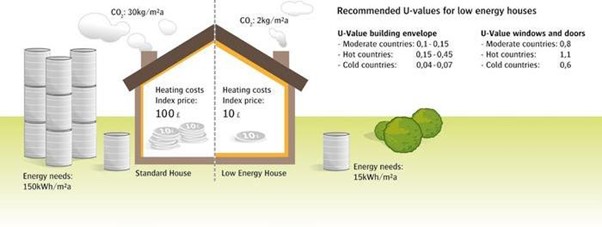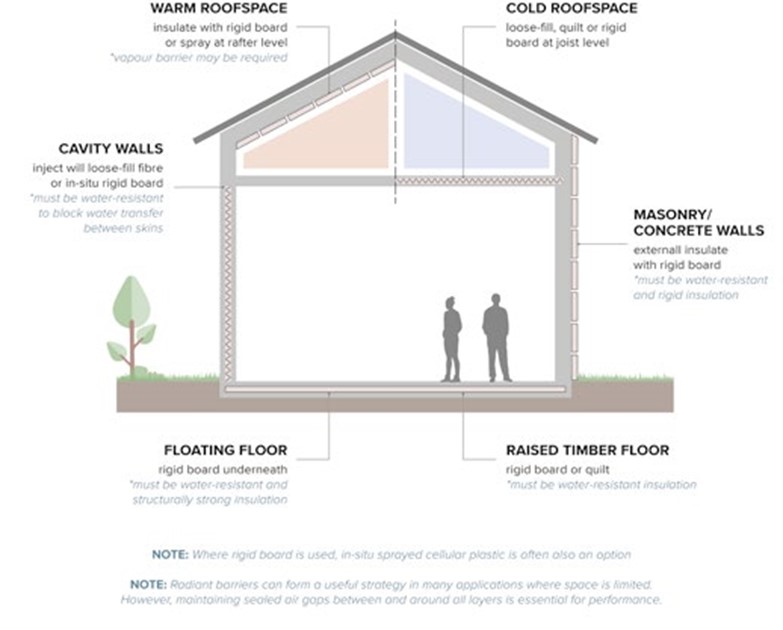Time to retrofit to secure a net zero future
Contents |
[edit] Introduction
If the UK is to have any chance of achieving its net zero carbon target by 2050, the existing building stock will have to be improved considerably with a comprehensive retrofit plan to improve thermal performance, reduce energy consumption and upgrade heating systems.
It is well known that Britain's housing stock is some of the oldest and poorest performing in Europe. With nearly six million houses built before 1919, the challenge before us is quite daunting as a good proportion of the UK's 29 million homes will need at least some improvement to reduce the 17% of total carbon emissions that comes from housing. [1]
[edit] Regulatory updates
Whilst higher standards for energy efficiency are being introduced for new build housing – the new and updated Part L of the Building Regulations for England came into force in June 2022, followed by new energy efficiency updates in Scotland and Wales in November and December 2022, and the Future Homes Standard for 2025 will require all new homes and other buildings to be built to ultra-high levels of energy efficiency, there is little to promote and deliver the improvements needed for existing buildings.
The government has a vague aim of upgrading existing homes to EPC C by 2035, but only where 'practical, affordable and cost effective'. This will require more than 15 million homes in England to be upgraded over the next twelve and a half years, but with no real strategy in place it is difficult to see how this can be achieved.
The Heat and Building Strategy published in 2021 expands on the detail of heat in buildings, but there is little on improving energy efficiency, reducing demand or the essential policy needed to support any large-scale approach to mass retrofitting.
If we are to move to a net zero carbon country by 2050 (2045 in Scotland), it will be vital to make improvements to homes and other buildings to reduce emissions. This means installing a whole range of energy saving measures; from better insulation and more efficient appliances, to replacing fossil fuelled boilers with low carbon alternatives such as heat pumps.
[edit] The role of insulation
The role of PIR and PUR insulation in upgrading our poorly performing housing stock and ensuring a sustainable future cannot be underplayed. Good insulation is essential and is one of the simplest and most cost-effective ways to reduce energy demand and cut CO2.
The lower the U-values in walls, floors and roofs, the less heat that is lost, resulting in enhanced thermal performance which in turn will help to deliver the standards required.
Highly effective and incredibly versatile, PIR and PUR insulation solutions are available in a range of forms including boards and blocks, cavity injected, composite panels, as well as spray and panel insulation. This with lambda values as low as 0.021 W/mK, PIR insulation performance can be achieved with less thickness than other commonly used insulation materials. Its exceptional insulating properties, high strength and light weight means it is used widely across residential, commercial and refurbishment projects.
Retrofitting insulation such as high-performance PIR is a valuable instrument in reducing heating demand, cutting CO2 emissions whilst addressing fuel poverty and improving comfort and wellbeing. Whether using internal or external insulation, it is vitally important the UK's housing stock is raised to an acceptable standard by making the fabric of the building as energy efficient as possible. Only then will we be able to provide a long-term asset that reduces energy usage and can be confidently passed on to future generations.
[1] Climate Change Committee’s Sixth Carbon Budget
This article first appeared in AT Journal issue 146 and was published on the CIAT website on 19 July 2023. It was written by the Insulation Manufacturers Association (IMA).
--CIAT
[edit] Related articles on Designing Buildings
Featured articles and news
RTPI leader to become new CIOB Chief Executive Officer
Dr Victoria Hills MRTPI, FICE to take over after Caroline Gumble’s departure.
Social and affordable housing, a long term plan for delivery
The “Delivering a Decade of Renewal for Social and Affordable Housing” strategy sets out future path.
A change to adoptive architecture
Effects of global weather warming on architectural detailing, material choice and human interaction.
The proposed publicly owned and backed subsidiary of Homes England, to facilitate new homes.
How big is the problem and what can we do to mitigate the effects?
Overheating guidance and tools for building designers
A number of cool guides to help with the heat.
The UK's Modern Industrial Strategy: A 10 year plan
Previous consultation criticism, current key elements and general support with some persisting reservations.
Building Safety Regulator reforms
New roles, new staff and a new fast track service pave the way for a single construction regulator.
Architectural Technologist CPDs and Communications
CIAT CPD… and how you can do it!
Cooling centres and cool spaces
Managing extreme heat in cities by directing the public to places for heat stress relief and water sources.
Winter gardens: A brief history and warm variations
Extending the season with glass in different forms and terms.
Restoring Great Yarmouth's Winter Gardens
Transforming one of the least sustainable constructions imaginable.
Construction Skills Mission Board launch sector drive
Newly formed government and industry collaboration set strategy for recruiting an additional 100,000 construction workers a year.
New Architects Code comes into effect in September 2025
ARB Architects Code of Conduct and Practice available with ongoing consultation regarding guidance.
Welsh Skills Body (Medr) launches ambitious plan
The new skills body brings together funding and regulation of tertiary education and research for the devolved nation.
Paul Gandy FCIOB announced as next CIOB President
Former Tilbury Douglas CEO takes helm.
UK Infrastructure: A 10 Year Strategy. In brief with reactions
With the National Infrastructure and Service Transformation Authority (NISTA).

























